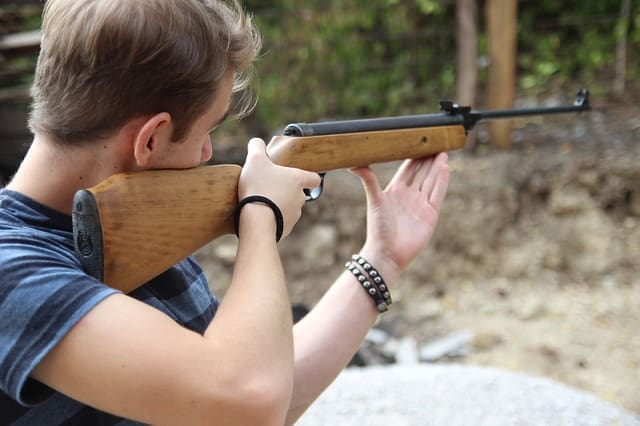The .22 LR (Long Rifle) and 9mm Luger are two of the most popular calibers in the U.S. and beyond, but for different reasons. Since people love comparisons and give vs.-articles lots of clicks, Gritr Sports decided to address people’s interest and prepare an overview of the performances of these two cartridges.
Generally, people compare them to handgun chamberings, forgetting about .22 rifles and 9mm carbines. We’ll address this as well.
So let’s begin with the ammo performance review and discuss different applications.
9mm vs. 22 LR – Ammo Overview
First of all, these two cartridges have completely different designs – the .22 LR is rimfire, and the 9mm is centerfire. The difference lies in the priming method. Rimfire ammunition has a protruding rim that contains the primer compound. The rimfire round is fired by the firing pin striking the rim. The primer compound sparks and ignites the propellant. Centerfire ammunition employs the primer sitting in the primer pocket on the base. It’s filled with the priming compound that sparks as the firing pin crushes it against the built-in anvil.
The centerfire priming method proved to be better than the rimfire because the centerfire ammo is more reliable and less prone to production flaws. Modern rimfire cartridges exist only in small calibers, such as our .22 LR. Bigger rimfire cartridges for semi-automatic pistols were supplanted by the equivalent centerfire ones, such as 9mm, .40 S&W, .45 ACP, and others.
On paper, the 9mm ballistics is superior to the .22 LR because it accepts a heavier and larger bullet and contains more powder because of a bigger case. The 9mm bullet is .355 inches in diameter and weighs 100-150 grains, while the .22 LR bullet is .223 inches in diameter and weighs 20-50 grains. This ensures better terminal performance, a higher speed, and less drop downrange of the 9mm. The .22 LR, in contrast, generates less muzzle energy and travels with slower velocity, which makes it an inferior defensive cartridge. However, being low-powered, the .22 LR generates the mildest recoil, less muzzle blast, and less noize.
Rifles significantly boost the ammo’s power because a longer barrel gives the round more time to build and use the pressure, resulting in higher velocity, power, and distance numbers. For those curious about the impact of barrel types on bullet performance, understanding the differences between a rifled barrel vs smooth bore is essential.
The .22 LR wins the 9mm in ammo cost because rimfire cartridges are cheaper and easier to produce. Nonetheless, the 9mm ammo is the cheapest in the centerfire category because it’s extremely popular, and the prices can be maintained low due to the economy of scale.
Although the .22 LR is inferior on paper, don’t underestimate it. It’s a live cartridge that can inflict damage and kill if the shot is properly placed. So don’t listen to the internet experts who squall the stopping power of the .22 LR is worth nothing. In fact, it will make more sense if we consider different applications.
Hunting

The .22 LR immediately wins this round because, originally, it was created for rifles and revolvers, whereas the 9mm cartridge was a traditional semi-automatic pistol chambering.
A .22 LR rifle is an excellent weapon for hunting small game animals like rabbits and squirrels. As opposed to .22 LR pistols, .22 LR rifles provide a longer effective range, up to 100 yards, within which a target can be consistently shot. Also, a smaller bullet won’t cause excessive damage to the animal’s meat or hide, and a quiet report won’t scare off other animals close to your hunting spot. Of course, the power of the .22 LR isn’t sufficient to take down a deer.
9mm rifles, otherwise called carbines, are not inherently designed for hunting. Small game hunting with a 9mm becomes a massacre because a bigger bullet destroys hide and meat and makes killing pointless.
Some hunters succeed in taking deer down with a 9mm carbine, but you need to be very close to the animal to kill it humanely. Even then, you may fail to reach the vitals, and the poor critter will die a needless death.
Personal and Home Defense
The point of self-defense is to stop an attacker by inflicting damage to vitals and causing sufficient blood loss. To achieve success, most importantly, you need to be accurate. A misplaced shot from a .22 firearm inflicts as much damage as one from a 9mm or .44 Magnum.
Since the .22 LR gives mild recoil and quiet report, firing a .22 LR rifle or handgun results in a tight sequence of shots due to fast target acquisition. However, 9mm also gives pretty manageable recoil, making firing a bigger-sized pistol or a carbine comfortable. Still, some shooters may experience difficulties with smaller-sized handguns chambered in the 9mm because of less mass to absorb the recoil.
A bullet should achieve sufficient penetration and expansion to stop the threat effectively. According to FBI standards, a bullet should penetrate ballistic gel at a 12-18 inches depth to reach vital organs and not over-penetrate. Designed as a combat cartridge, the 9mm meets this standard perfectly, whereas the .22 LR often fails to go at a minimal depth. However, a .22 LR rifle can fix this because a bullet gains more energy in a longer barrel.
As for expansion, the 9mm hollow-point ammo leaves a larger wound cavity due to a larger bullet. Moreover, faster velocity aids expansion, so 9mm bullets always mushroom on impact. Small bullets of the .22 LR, on the other hand, leave a smaller wound channel and often fail to expand at all because of slower handgun velocities. The .22 LR rifle velocity is sufficient to achieve expansion, but lighter bullets can fragment on impact.
So, compared to the other defensive centerfire cartridges, the 9mm cartridge is considered the best for self-defense because it achieves sufficient penetration and expansion and generates relatively soft recoil. Besides, the centerfire technology is more reliable. Though no one will feel great when hit with a .22 LR bullet, it’s definitely not the first choice for self-defense. However, it may become one for people who lack hand strength or are scared of a gun report and can’t shoot bigger calibers.
Target Shooting / Practice / Training


Recreational target shooting and training imply many fired rounds, so you need a budget cartridge that won’t break the bank. Both 9mm and .22 LR are great in cost per round, though the latter is sufficiently cheaper. You can buy a brick of five hundred rounds of the .22 LR and spend all day at a range.
As far as training is concerned, the easy-shooting .22 LR is a great introductory cartridge for the elderly, young, and disabled. However, some people may find it boring. The 9mm is more challenging and, thus, fun to shoot. Besides, if you’re focused on self-defense, you should start practicing with a cartridge that you plan to use outside the range.
Conclusion
Both 9mm and .22 LR have pros and cons, making them more or less preferable for different shooters. The .22 LR is best for training and low-cost recreational shooting. A .22 LR rifle can be a great option for hunting small game. It wouldn’t be the first recommendation for home or personal defense, but a properly placed shot from a .22 LR firearm will be painful. So if you can’t shoot bigger calibers for some reason or already have a .22 LR rifle or handgun, use it.
A 9mm firearm is ideal for defensive scenarios. A 9mm pistol is comfortable to shoot and offers nice capacity. If we take Glocks, one of the more popular pistols for self-defense, the mag capacity is as follows: 17 rounds for the full-size Glock 17, 15 for its compact version, the Glock 19, and 10 for the Glock 26 subcompact pistol. A 9mm carbine is even more pleasant to shoot since it has more mass to absorb recoil. However, the 9mm cartridge is not intended for hunting.
Featured Image by Egor Shitikov from Pixabay




